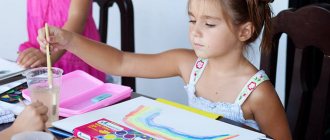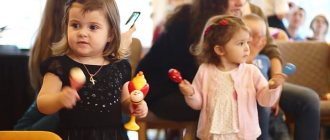Features of the emotional development of a preschool child
The problem of our time is that many children have problems in emotional development, namely, they do not know how to respond to the feelings and states of others, and react inadequately to many things. Today, a child’s best friends are a TV and a computer, a smartphone and a tablet, and his favorite activities are watching cartoons and computer games. As a result of this lifestyle, children communicate less with both adults and peers; Preschoolers are not attentive and insensitive to others, they do not know how to control and show emotions appropriately. But communication significantly enriches life, making it bright, filled with emotions and impressions.
The preschool period is a fairly short period of human life. Therefore, it is important to lay good personality foundations at this time. Equally important is the emotional development of the child, which has its own special characteristics.
When a child is 1-3 years old, his emotional sphere is characterized by:
- lack of empathy
- characteristic emotional reactions associated with his desires
- inability to choose and make decisions
- egocentrism
- the emergence of self-awareness (the baby begins to recognize his reflection in the mirror, respond to his name, tries to be independent, begins to use the pronoun “I”
- high self-esteem (I am good)
- inability to see the consequences of actions
- the importance for the child of an adult’s assessment and reaction.
At the age of 4-6 years, the emotional sphere of the child is characterized by:
- a calmer emotional background of perception
- manifestation of emotions along the chain “desire, idea, action, emotion”
- more controlled emotional processes
- development of emotional anticipation (the child tries to anticipate the future result and how it will be evaluated)
- the appearance of affective reactions
- the emergence of new motives for activity
- the ability to evaluate one's behavior.
A 4-5 year old child is a small person with a fairly diverse range of emotions. His feelings and experiences are connected, to a large extent, with the atmosphere in the family circle. New skills and interests contribute to the emergence of a whole range of different emotions of the child, as well as needs and motives. A preschooler's range of emotions and feelings gradually becomes more complex: he can already feel not only joy or fear, but also jealousy, sadness, pity, anger, cheerfulness, tenderness, shyness, surprise, pleasure, etc. A preschooler can already express feelings using different intonation and facial expressions.
Features of the development of the emotional sphere of preschool children:
- they still cannot control their emotions and experiences
- they master social forms of expressing feelings
- their feelings and emotions become more reasonable and voluntary
- preschoolers begin to develop higher feelings (aesthetic, moral, intellectual).
Watch a video about the importance of emotional and sensory education of a person
If you want to find out to what extent your child has developed certain emotions and feelings, we recommend that you resort to methods for diagnosing the child’s emotional sphere.
The emotional sphere is an important component in the development of preschoolers, since no communication or interaction will be effective if its participants are not able, firstly, to “read” the emotional state of another, and secondly, to manage their emotions. Understanding your emotions and feelings is also an important point in developing the personality of a growing person.
Throughout preschool childhood, the “education of feelings” occurs - over time, they become deeper, more stable, and more intelligent.
The strongest and most important source of a child’s experiences is his relationships with other people, adults and children. When others treat a child kindly, recognize his rights, and show him attention, he experiences emotional well-being—a feeling of confidence and security. Usually, under these conditions, the child is in a cheerful, cheerful mood. Emotional well-being contributes to the normal development of a child’s personality, the development of positive qualities, and a friendly attitude towards other people. Emotional well-being also provides high self-esteem, formed self-control, orientation towards success in achieving goals, emotional comfort in the family and outside the family. It is emotional well-being that is the most capacious concept for determining the success of a child’s development.
In preschool age, that relatively stable inner world is formed, which gives grounds for the first time to call a child a personality, although, of course, a personality that is not yet fully formed, but capable of further development and improvement.
The main way adults influence the development of children’s personality is through organizing the assimilation of moral norms that regulate the behavior of people in society. These norms are acquired by the child under the influence of models and rules of behavior. Models of behavior for children are, first of all, adults themselves: their actions, relationships. At the same time, of course, the most important component of an adult’s influence on a child is his, the adult’s, own system of emotional reactions, assessments, and characteristics.
The behavior of the people immediately around him has the most significant impact on the child. He is inclined to imitate them, adopt their manners, borrow from them their assessment of people, events, and things. However, the matter is not limited to loved ones. A preschool child gets acquainted with the life of adults in many ways: by observing their work, listening to stories, poems, and fairy tales. The model for him is the behavior of those people who evoke the love, respect and approval of others. The behavior of peers who are approved and popular in the children's group can also serve as a model for the child. Finally, the patterns of behavior presented in the actions of fairy-tale characters endowed with certain moral traits are of considerable importance.
If an adult is friendly to the child, rejoices with him in his successes and empathizes with his failures, then the child retains good emotional well-being, a readiness to act and overcome obstacles even in the event of failure. When a positive relationship is established with an adult, the child trusts him and easily comes into contact with others.
In our kindergarten, every year a diagnosis of the emotionally-volitional sphere of personality and the emotional state of the child in the kindergarten group is carried out. I would like to note that most children have recently, compared to previous years, experienced a decrease in the level of development of the emotional sphere, an increasing number of children are experiencing difficulties in communicating with peers, awareness of their emotions and control over them are reduced. Frequent conflicts arise between children, which they do not know how to resolve. Unfortunately, we have to note that children become less responsive to the feelings of other people.
At all stages of a preschooler’s physical development, it is necessary to expand knowledge about emotional phenomena, the emotional sphere of a person and one’s own emotional manifestations. By explaining what emotions are, how they are expressed and what the consequences of emotions are, we form a vocabulary of emotions, activate ways and means of identifying emotions, thereby facilitating the child’s communication with the outside world, developing his cognitive potential and forming the foundations of morality. For example, in a role-playing game, a child accepts a situation “as if” and at the same time, without changing himself, maintaining contact with reality, experiences real emotions in accordance with the plot.
It is also necessary to enrich the positive emotional experience of children, and through replaying emotional experiences, relieve tension, anger and develop independent skills in dealing with negative emotions.
An important part of enriching the emotional sphere of a preschooler is also the expansion of the means of expressing emotional states and the formation of skills for voluntary expression of emotions. By conducting creative games such as “Complete the face” or “Find differences in facial expressions”, discussing facial signs, the teacher helps the child with solving this issue.
The proactive initiative of an adult is the main feature in correcting the child’s sphere of communication and expanding his emotional sphere.
Parents and educators of preschool children should pay great attention to role-playing games, acting out various scenes with emotional overtones, it is necessary to attend theatrical productions, circus performances, look at paintings and listen to musical compositions with different emotional overtones.
Psychogymnastics should be used in work. Psychogymnastics is a course of special classes (studies, exercises and games) aimed at developing and correcting various aspects of the child’s psyche (both its cognitive and emotional-personal spheres).
It is also necessary to note games for the development of emotional expression, or emotionally expressive games. They are aimed at developing facial, pantomimic, speech motor skills, gestural expressiveness - in other words, the “language” of emotions, which create a favorable background for the manifestation of individuality, the development of emotional sensitivity, etc. They are used in joint activities, starting from the middle group; By the age of four, children have developed a certain emotional and sensory experience, and they are able to act from a certain person, orient themselves to the attitudes of an adult, etc.
When working with children, it is advisable to use the works of children's writers and poets, folklore. They are a special form of understanding the surrounding reality, forming an emotional attitude towards the world. Fairy tales, short stories, nursery rhymes, etc. enrich the vocabulary of emotional vocabulary, develop an imaginative worldview, responsiveness, and serve as an excellent occasion for a meaningful dialogue between the teacher and children.
Objectives and options for practical activities for each age group.
Second junior group.
The main tasks at this age stage are:
— Encouraging children to react emotionally through the targeted supply of sensory information through the channels of the visual, auditory, vestibular, olfactory, tactile and taste analyzers;
— Maintaining the expressive manifestations of children (facial expressions, gestures, speech) in the process of interaction with sensory stimuli that differ in modality, intensity, and duration.
To implement these tasks, we can recommend the following sensory games.
"Travelers"
The teacher suggests walking barefoot on different surfaces (soft, smooth, ribbed, etc.).
Games with water - launch boats, bathe toys, fill plastic containers, rubber toys (pears) with water and pour it out, plunge plastic balls and toys to the bottom.
“It’s raining” (pouring water from a watering can into basins).
“Who can hold the water longer” (they collect water in their palms, trying to hold it for as long as possible).
“The sea is agitated” (hands depict sea waves).
"Breeze"
The teacher holds in his hand a plume to which light ribbons are attached, and says the following words:
Wind, blow stronger
Unfurl the ribbons quickly.
Wey, wey, breeze,
Get him, buddy!
Then he begins to move quickly, waving his plume. Children try to catch the “breeze”.
In parallel with sensory games, it is recommended to conduct games aimed at developing the mechanisms of emotional expression, primarily gestural expressiveness.
The plot basis of such games can be the works of children's writers, poets, and folklore.
"Bear Cubs"
The teacher reads P. Voronko’s poems, inviting the children to move.
The cubs lived in the thicket, turning their heads. Like this! (They shift from foot to foot, turn their head.)
The cubs were looking for honey and shook the bush together. Like this! (Imitate the swaying of bushes.)
They waddled and drank water from the river. Like this! (They waddle, awkwardly, then bend down, “drink water.”)
And then they danced, raising their paws higher. (They dance, raising their knees high.)
In the second younger group, it is also necessary to introduce children to vocabulary that reflects the most vivid, visually easily identifiable emotional states: joy (joyful, joyful), sadness (sad, sad), fun (cheerful, cheerful, etc.), sadness (sad , sad, etc.), fright (scared, scared), anger (angry, angry), etc.
The main role in solving this problem is played by literature and folklore. When reading fairy tales, short stories, etc., the teacher focuses children’s attention on words that characterize certain emotional states. At the same time, you can demonstrate the manifestation of emotions in gestures, facial expressions, intonation, and encourage children to identify emotional states using questions: “Why did the bear run away when he heard the fox’s song?”, “Do you think the goat has always been cheerful? What else was she like?” etc.
Children of this age must also learn to see and reproduce the characteristic features of the design of emotional states (joy, sadness, fear, anger). For this, it is appropriate to use illustrative material, theatrical activities, etc. For example, using a series of story pictures and sets of cards depicting the main character in different emotional states, the teacher invites children to choose a card for each story picture that matches the hero’s mood.
Middle group.
At this age stage, it is necessary to solve many more problems related to the emotional development of children. This is primarily an expansion of the experience of emotional response through the introduction of various sensory stimuli, often complex (visual - vestibular, visual - auditory - tactile, etc.)
For the development of emotional expression, its mechanisms: non-verbal (facial, pantomimic, gestural) and verbal (words, sounds, phrases), as well as the formation of the foundations of expressiveness of external emotional manifestations, it is advisable to use emotionally expressive games (children embodying various situations from the life of animals, their habits; conveying the emotional states of fairy-tale characters through personification, etc.). Taking into account the age characteristics of children, the emotional-game context is specific, prompting and guiding.
In middle preschool age, it is also important to replenish the “emotional” vocabulary with words denoting various moods, states (surprised, surprised, scary, scared, angry, angry, grief, grieving, cowardly, offended, sad, mischievous, etc.); phrases that reflect shades of mood (not very angry, not at all scary, very sad, etc.); learn to select synonyms (joyful - cheerful, sad - sad, sad); find words that specify emotional states: angry (unpleasant, rude, angry); cheerful (happy, laughing); understand emotional characteristics presented in the form of phraseological units: Masha is confused, the girl is picky, good doctor Aibolit, etc.
To make it easier for children to master an emotional vocabulary and develop the ability to analyze emotions using words, they should first turn to fiction. It is also advisable to use visual models - a series of paintings reflecting episodes of fairy tales and stories. By showing this or that image, the teacher suggests remembering the hero’s mood and giving him a generalized emotional description.
You can make a cardboard circle with a moving arrow and depicting animals and people in different emotional states. Pointing to one of them, the teacher asks the children to name this mood, choose words - synonyms (sad hare, what else?).
To continue a meaningful dialogue with children, turning to other types of activities will allow you to turn to other types of activities: visual (the teacher, together with the children, draws Masha the Confused Man, the good Doctor Aibolit, etc.), musical (selecting musical accompaniment for fairy tales).
It is advisable to teach children to identify and differentiate emotional states (joy, sadness, fear, surprise, anger) based on external signs, and to notice changes (transitions) in mood.
To solve these problems, you can conduct conversations using pictograms, games, for example, “Confusion.”
The teacher places in front of the children a large sheet of thick paper on which people, animals, various objects, natural phenomena, etc. are drawn, connected to each other by winding lines of various colors. Offers to figure out who (or what?) the puppy, mouse, bird, etc. are afraid of; who (or what) upset the girl; who (or what) amused the boy, etc. Then, he offers his options for correcting negative experiences. For example, how to calm a puppy, how to help a girl overcome sadness, etc.
It is advisable to introduce children to the “Book of Moods”. It is created by the teacher. To do this, you need to bend five to six landscape sheets in half and fasten them in the middle. Even-numbered pages represent symbolic images of various moods (pictograms), and odd-numbered ones reflect life situations, episodes of fairy tales, cartoons, objects, phenomena that can cause a particular emotional state. When considering the “Book of Moods,” it is advisable to encourage children to supplement its content with their own life experiences (name what (who) brings you joy; what can make you sad, what it means to be offended, etc.).
You can complete tasks in the “Rainbow of Moods” albums, which require conveying emotions with color. For example:
· The teacher depicts the girls’ faces in a state of joy and sadness, asks them to draw a dress, bows, shoes that suit each of them.
· The teacher draws pictograms and several circles around them. Invites children to depict in circles objects, events, etc. that can evoke a particular mood.
· Depicts episodes from fairy tales (cheerful and sad animals around Aibolit, guests at Soroka’s name day - white-sided, etc.), offering to color each character according to his emotional state.
Senior preschool age.
The tasks of this age period include the following:
· Improving the experience of external expression of emotions, encouraging the transfer of subtle shades of mood, demonstrating the diversity of components of emotional expression: facial expression, pantomimic, gestural, speech;
· Stimulating the manifestation of an individually unique style of play behavior, originality of emotional response.
To achieve these goals, it is recommended to conduct a series of emotionally expressive games. Here are some of them.
Older children continue to be taught to understand, differentiate the emotional state based on external signs (facial expressions, gestures, postures, voice intonations), determine the reasons for a particular mood by analyzing circumstances, events, etc.; They develop the ability to respond to the emotional state of another person, to show empathy, joy, and action.
In the implementation of these tasks, fiction, especially landscape poetry, provides great assistance, where various moods and connections between human experiences and the state of nature are conveyed. An important place is given to conversations and games.
Using problematic situations and visual material, you can dwell on such points as the reasons that cause certain emotional experiences, ways to change negative experiences.
In the future, it is recommended to bring children to the idea: a person’s mood largely determines his view of the world around him, relationships between people, etc.
In the course of joint activities, work continues to enrich the vocabulary of emotional vocabulary (indifferent, pathetic, greedy, capricious, lazy, offended, ashamed, boring, tired, etc.), while it is important to encourage children not only to name emotional states, but also to select synonyms, highlight shades of mood, trace associative connections with color. While reading excerpts from works of fiction, the teacher suggests characterizing the features of the external expression of a particular state (for example, what does tired mean); reproduce this state with movements, choose a color that matches it.
In communication, it is important to pay attention to the figurativeness of the stylistic forms of children’s speech.
Children continue to be taught to understand emotional characteristics in the form of phraseological units and to use them adequately (Tsarevna - Nesmeyana, Vovka - a kind soul, The Ugly Duckling, etc.). To do this, it is necessary to introduce children to works containing such collective images: A. Barto (“Vovka is a kind soul”, “Girl is a roarer”), G. H. Andersen (“The Ugly Duckling”, “Thumbelina”), The Brothers Grimm ( “Cinderella”), S. Marshak (“He’s so absent-minded”), Y. Akim (“Neumeika”), S. Mikhalkov (“Foma”), the fairy tale “Kroshechka - Khavroshechka”, etc.
You can create an album “They live among us” (each drawing is thoroughly thought out together with the children: background, pose, facial expression, surrounding objects, etc.).
It is recommended to hold conversations and evenings of entertainment, for example, “Journey to the Land of Familiar Heroes.” The teacher prepares in advance silhouette images of the Princess - Nesmeyana, the Ugly Duckling, the Scattered One from Basseynaya Street, etc. Offers to go to an amazing country, where they will meet interesting characters.
Thus, the emotional development of preschool children is one of the most important areas of professional activity of preschool teachers.
Diagnostics
Basic diagnostic methods for the emotional sphere of children:
- testing
- observation
- survey
- conversation
- survey
- analysis of samples of children's creativity (drawings).
When observing a preschooler, pay attention to factors such as emotional background, mood, degree of expression of emotions, level of emotional mobility. By observing, you can easily notice how rich the child’s emotional background is, whether the child knows how to control his emotions, and whether he is characterized by emotional instability.
Using one of the diagnostic methods or in combination, you can find out:
- How adequate is the preschooler’s reaction to phenomena?
- how he perceives and interprets the states and moods of other people
- the breadth of the range of emotions that the child understands and experiences, the depth of his experiences, ways of conveying emotions through speech;
- Is it appropriate to display emotions during communication?
These methods can be used by both professional child psychologists and kindergarten teachers.
Diagnosis of the emotional sphere of preschool children
Both the institution’s psychologists and the parents themselves can study the level of development of the emotional sphere.
- Amen's anxiety test. The child is offered several pictures where the outline depicts children at different moments: in class, in a game, during a conversation with the teacher. The child must imagine the face of the children in the picture: happy or sad, and answer why he thinks so. If the baby notices negative manifestations in most of the pictures, then we can talk about increased emotional anxiety of the subject.
- Luscher color test. The child uses color to show his attitude to the situation being described.
- Drawing tests. Diagnostics takes place in two stages: drawing and discussion. A theme for the drawing is given, for example, “I’m in class,” “The road to kindergarten.” There is no time limit for illustration. The specialist records all the events that happen while the child is working: how often he paused, what he erased from the drawing, the little artist’s comments. After finishing the work, the presenter is interested in what the child drew, who he depicted next to him, what emotions the characters in the picture experience and why.
Empathy in children
The most important component of the emotional development of a preschool child is the development of empathy, namely the ability to sympathize and understand the experiences and emotions of other people. A child who has developed empathy will always put himself in the position of this or that person and offer him his help.
"This is interesting. The author of the theory of emotional intelligence, Daniel Goleman, is convinced that success in life depends not only on the level of intelligence, but also on a good ability to manage one’s own emotions. And by understanding one’s own emotions, a person will feel and be aware of the emotions of others.”
Forming empathy in a preschooler is the key to successful schooling, easy socialization, and problem-free communication. If only for this reason, parents should definitely pay attention to the development of empathy along with the development of the child’s intellectual, communication, cognitive, creative and other abilities.
Tips for developing empathy:
- Create a warm atmosphere in the family where love and mutual understanding will reign.
- Discuss different life situations with your child.
- Introduce your child to the principles of existence in society.
- Explain how to properly deal with people in different situations.
- Explain what consequences this or that behavior of people may have.
- Develop positive social character traits in your child: optimism, trust, forgiveness, solidarity.
- Teach your child to do useful things and help others. Don't forget about praise.
- Empathize with the child, communicate with him about how he feels.
- Develop your child emotionally: discuss thematic images and photographs, depict emotions in front of the mirror, play emotional games.
- Be a role model for your child: adhere to the same principles that you teach your child.
Rules of emotional education
Emotional education of a child does not require large physical and time expenditures. You just need to follow some rules.
1. Voluntariness of expression. Teach your child to show his emotions, name them, and understand his feelings. This is especially important for young children who need to let out everything that has accumulated inside. Discuss his feelings with your child, giving him the opportunity to cope with the emotions that arise on his own.
2. The power of expression. Older children should learn to control their emotions: laugh quietly, collect their thoughts, restrain anger, cope with excitement. Teach your children simple self-control skills and monitor your own behavior.
3. Empathy. Children should not be indifferent. If your child does not worry about cartoon characters or other people, then he needs to be taught empathy. Ask him how he feels, whether he feels sorry for the hero, whether the child wanted to help. Discuss life situations with your child. Offer to describe the feelings and sensations of the participants in the events. Think about how you can show your concern towards another person: congratulate, express sympathy, help in something. Free your children from envy and gloating from childhood, this will make them happy
Emotional impact
The secret of raising a preschooler with the help of emotional influence is not to suppress the child’s emotions, but to direct them in the right direction.
If a child attends kindergarten, then his emotional development will be more effective, since he will be in the company of peers and, together with them, comprehend new things, learn to communicate with them.
Work on the emotional improvement of preschoolers should be carried out in two directions:
- developing the ability to recognize and compare emotions: fun, boring, sad, calm, scary, interesting, etc.
- developing the ability to correctly express emotions and identify the emotions experienced by others.
The emotional impact on the child is carried out by the following means:
- role-playing games
- psycho-gymnastic games
- outdoor games
- communication games
- games and tasks to develop arbitrariness
- games for developing imagination
- game exercises
- mimic sketches
- listening to music and discussing it
- reading fairy tales and stories
- acquaintance with painting.
During classes, the child will experience different emotional states, will try to talk about what he feels, will get acquainted with the experiences of the same children, thanks to which he will begin to better understand himself and those around him.
Formation of the emotional sphere
The formation of emotions and feelings in preschoolers depends on the following conditions :
- A preschooler must communicate with peers: it is in communication that feelings and emotions are formed.
- It is necessary to organize purposeful activities that promote the development of emotions and feelings (listening to music, music lessons, reading).
- It is best to develop emotions and feelings in preschoolers through their main activity - play.
- Labor and creative activity helps to form emotional experiences: joy from success, inspiration, sympathy for the efforts of peers, a feeling of satisfaction or dissatisfaction with the result.
“Did you know that if a person is emotionally well, then he has high self-esteem, he is goal-oriented, has no communication problems, and can easily build and maintain relationships. That is, emotional well-being is a guarantee of a child’s success in the future. The emotional well-being of a child depends not on his innate characteristics, but on the optimal system of upbringing in the family.”
Components of successful formation of the emotional sphere of a preschooler:
- Proper organization of the child’s routine, comfortable for him.
- Activation of the baby’s motor activity, his physical development (morning exercises, outdoor games, physical education sessions).
- Games (role-playing, story-based, didactic, communicative, etc.).
- Introduction to art and independent creativity.
- Reading and discussing fairy tales.
- Psycho-gymnastics (emotional sketches, facial expressions, pantomime).
- Organization of joint activities of children.
- Tasks using visual aids.
Emotions are the basis for a child’s successful mental state, his successful communication, development and future life. The baby reacts to the world around him through emotions. Therefore, it is necessary to develop the emotional sphere of a child from an early age using different types of influence, giving preference to play methods.
Correction of the emotional sphere of preschool children
- Games to eliminate emotional stress. During such exercises, the preschooler learns to show his feelings using words and gestures. For example, in a game, the teacher invites participants to hug their friend and pat him on the shoulder or head. Or, dancing in a circle, children try to show a sad bear or a happy squirrel with their movements.
- Psycho-gymnastics. Exercises that alternately cause tension and relaxation will help relax muscles and relieve nervous excitement.
- Music therapy. Classical music puts the baby in a positive mood and neutralizes depression.
- Games to imitate the mood.
- Massage points on the palms, face, crown, under the kneecap.
The full and correct development of the emotional sphere is extremely important for the formation of the personality of a preschooler. After all, it affects the cognitive processes and motivation of the child’s behavior.
By









